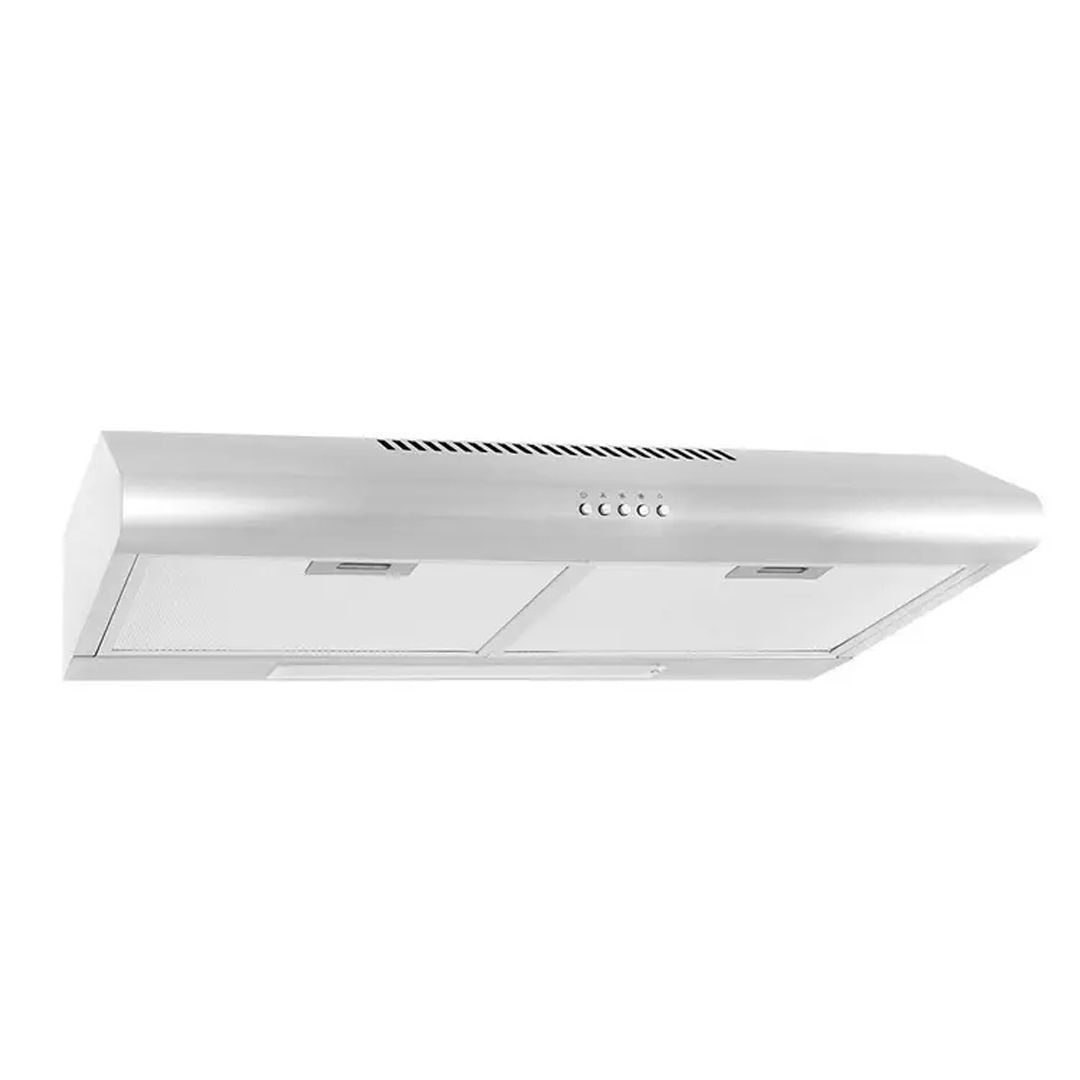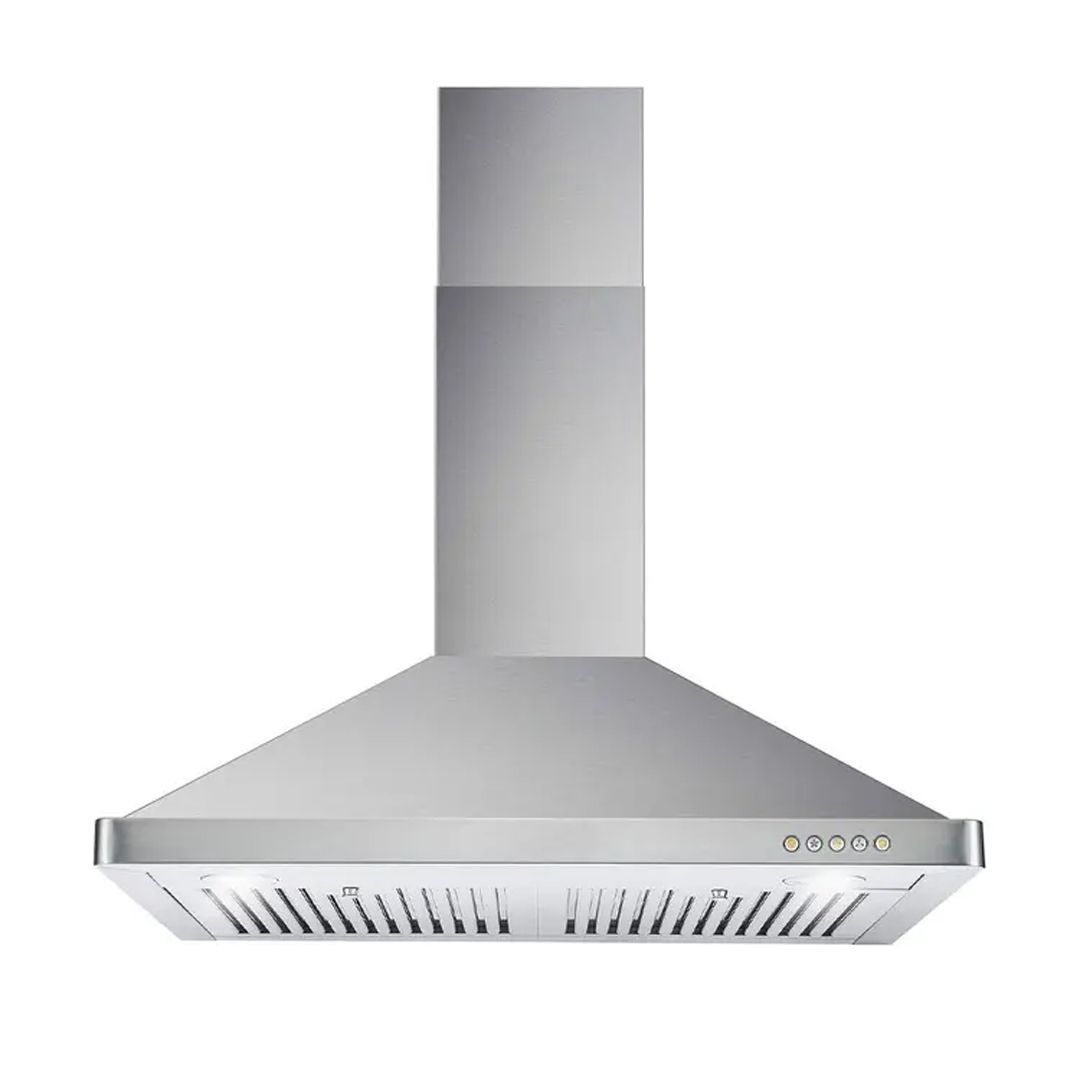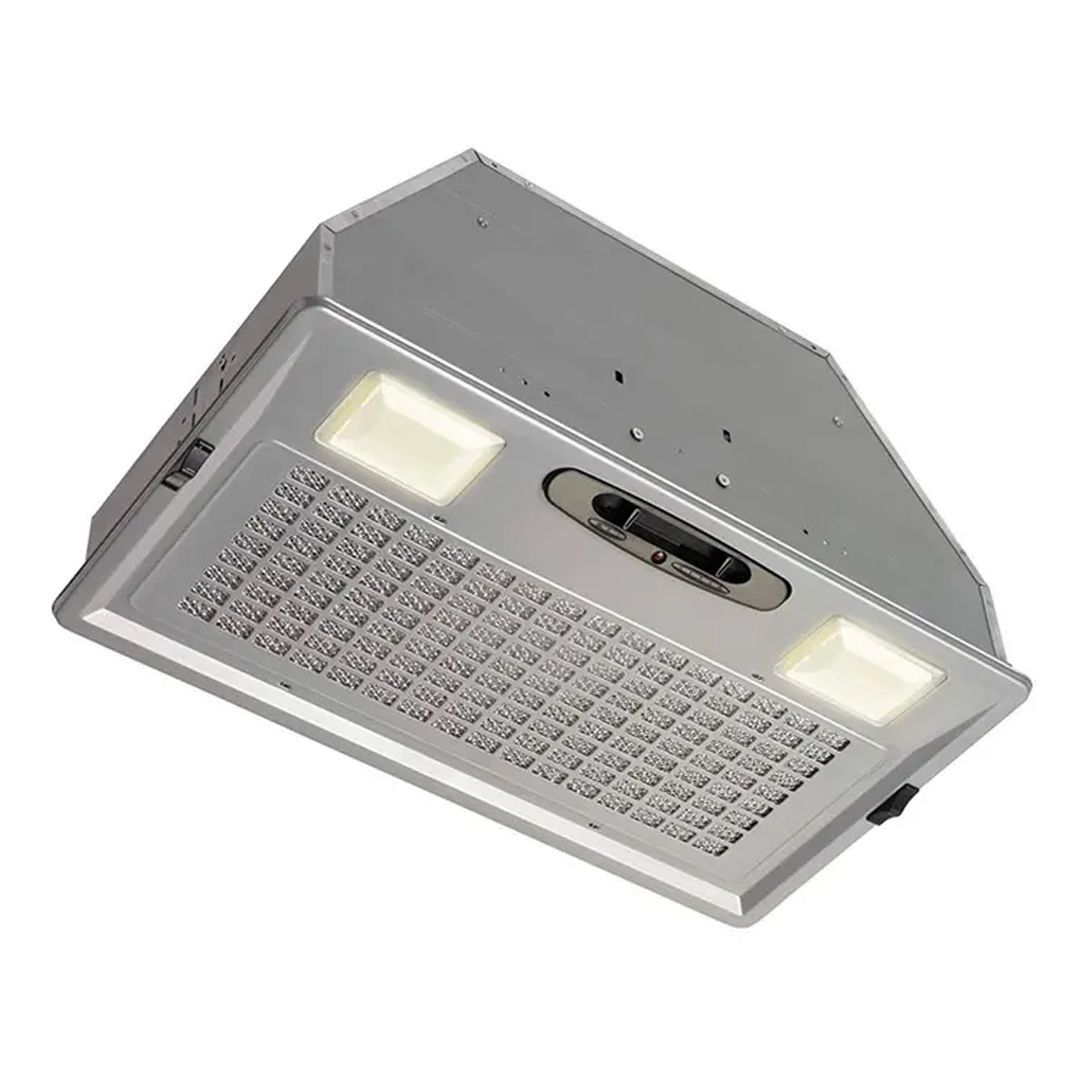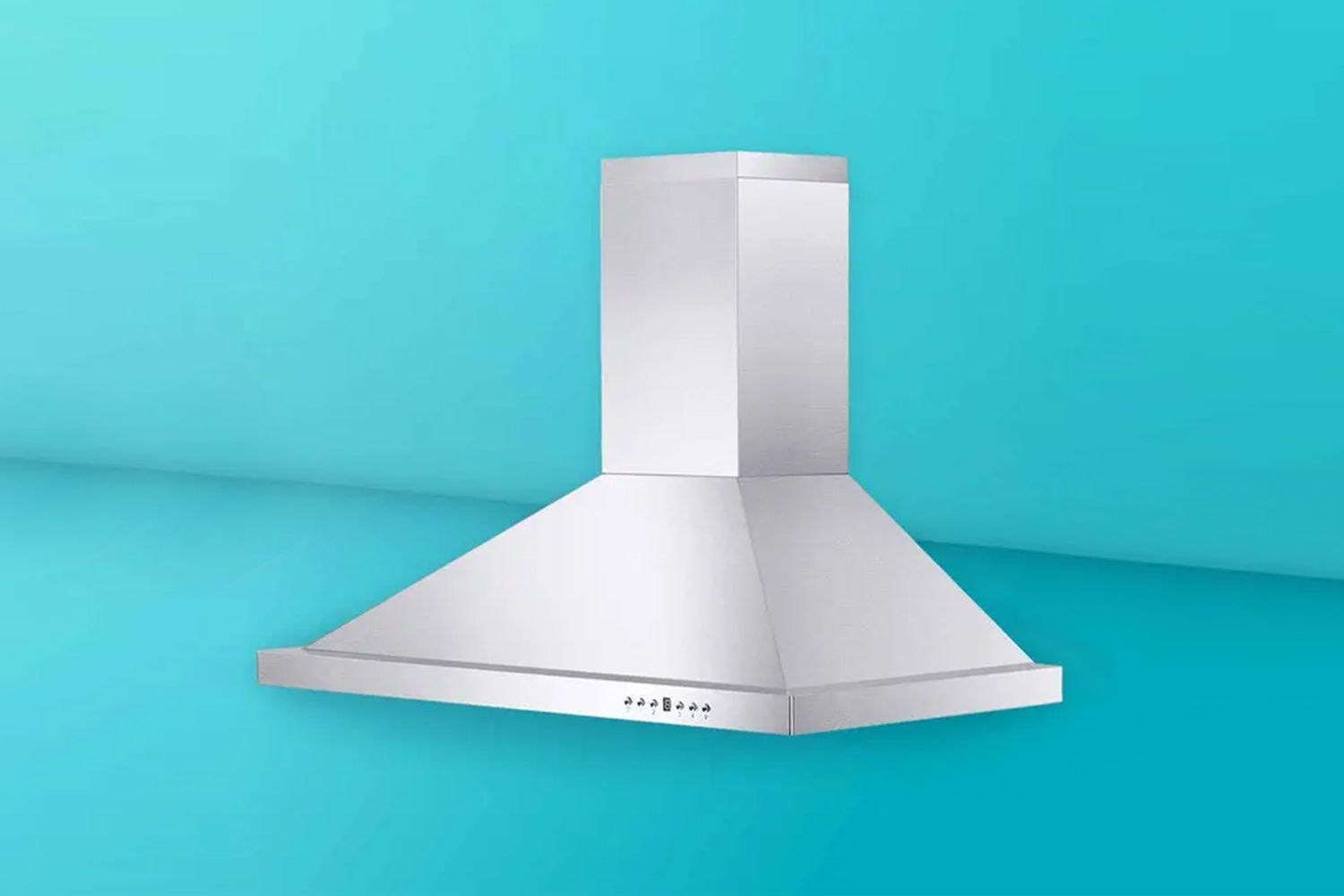Best Ductless Range Hoods in 2024 Buyer’s Guide & Reviews

Range hoods are an important part of any modern kitchen, as they help keep air quality at a safe level. They do that by sucking in most of the emissions released during cooking and leading them through an airway duct that vents to the outside.
While most exhaust hoods vent air out of the home, some remove harmful agents and odors by filtering them, instead. Those are called ductless range hoods. But what exactly is a ductless hood? Why would you want it instead of a ducted unit? And what would be the best ductless range hood right now?
Everything we recommend
The Broan 41000 is quite an old line of ductless range hoods, but its effectiveness speaks for itself. With its compact casing, multiple size choices, and consistent performance in improving air quality, the series has been in the lead for many years.
As a brand in the range hood market, Cosmo has grown in popularity in recent years, and the Cosmo 5MU series has two of the brand’s best selling convertible or recirculating-optional hoods. The models feature stainless steel construction, an option for recirculation, and a comparatively high CFM rating.
For a wall-mount alternative, we recommend the Cosmo 63175. The hood wins over users with its sleek look, quality build, and powerful performance.
For medium-size kitchens with aesthetic orientation, this Broan hood insert and its fitting for hood covers are going to be a great fit. The model offers a well-balanced combination of functionality and cost.
For the best high-tech ducted/ductless hood, we recommend the Cosmo QS75— a high-end, heavy-duty convertible range hood with strong specs and a range of high-tech features.
What Are Ductless Range Hoods?
Rather than extracting air, ductless or non-ducted range hoods recirculate air. Recirculation improves air quality around the cooking area by cleaning and redistributing it.
As with exhaust hoods, recirculating hoods use a fan to suck in air along with harmful pollutants. But instead of leading the air outside, they clean it by running it through degreasing filters and charcoal carbon filters and then returning it to the room.
Since ductless hoods don’t remove air from the kitchen, they don’t require ventilation ductwork, which means you’ll save a lot of time, effort, and money. You also don’t need to sacrifice cupboard space for the air duct.
Ductless Range Hood Buying Guide
Keep these details in mind when shopping for a ductless range hood:
1. Effective Area
As a rule of thumb, a hood should be at least the same or one size bigger than that of the range. For example, a 30-inch range should have a 30-inch or 36-inch hood. The rule ensures that the hood of choice has enough coverage to capture all of the emissions from the cooktop.
With hoods installed over a kitchen island, professionals suggest going one size (6 inches) bigger. The extra coverage compensates for the lack of a back wall, which helps limit air movement.
2. Filters
Carbon filters are crucial to ductless hoods. They help purify the air by trapping odors and invisible pollutants, but they don’t last forever.
You’ll need to replace your carbon filters two or three times a year— more regularly if your cooking is frequent or particularly smoky. You can usually save money by buying replacements in bulk.
3. Suction
In comparison with ducted hoods, ductless units have weaker blowers, even the best ones. Their powering ratings stay around 200 CFM. If you’re wondering why the suction is so low, it’s by design. Because ductless hoods filter and redistribute air rather than extracting it completely, they require less power.
While a lot of suction is a definite advantage, it’s not a clear indicator of performance for non-ducted units; the effectiveness of the filtration system is arguably more important.
4. Price
A recirculating hood rarely sells for more than $100, thanks to the low power rating and economical build. Ductless convertible units, however, cost about the same as ducted exhaust hoods: up to around $400 with high-end models.
Broan 41000 Series Ductless Range Hood
Best Overall
The Broan 41000 is quite an old line of ductless range hoods, but its effectiveness speaks for itself. With its compact casing, multiple size choices, and consistent performance in improving air quality, the series has been in the lead for many years.
- Affordable
- Slim design
- Multiple sizes
- Reliable quality
- Aluminum degreasers wear out
Basic but Effective Specs
The 41000 series comes in a variety of sizes, from 21 to 42 inches wide. The most common size is 30 inches, in accordance with the average size of most cooking ranges.
Their suction ratings are similar and peak at around 190 CFM. The series has a compact, under-cabinet body frame and works best when installed 18-20 inches above the counter.
Models in this series use aluminum mesh filters to degrease smoke and other cooking emissions. Added charcoal carbon filters help take care of odors and fine particles.
Cleanup and Maintenance
You can remove, clean, and reuse the aluminum mesh filters, but they will eventually need to be replaced. Aluminum wares usually don’t go in dishwashers. So unless the manufacturers say they’re dishwasher-safe, you should clean them by hand using warm water, mild degreasing soap, and baking soda.
The charcoal filters are not as resilient as the meshes and need more regular replacement. They can stay effective for as long as 6 months, or about 120 hours of cooking, and they’re not reusable.
These hoods also wear a spot-resistant coating. To clean it, all you need to do is wipe the exterior with a damp cloth.
Easy Installation
Even if there’s no need for ductwork, installing the 4100 series is pretty easy. Because they’re all under-cabinet hoods, they need the cabinet as a platform, which means you don’t have to put in the work to remove the cabinet as you do with wall-mounts.
In customer reviews, owners have said they were able to set these hoods up and have them running in 40 minutes or so.
Highly Regarded
The 41000 series has been around for more than a decade, and it continues to enjoy positive reviews and recommendations.
Additionally, Broan’s products for commercial and residential uses are reportedly reliable. Throughout our research on the series, we’ve noticed very few consistent problems as well as service-relating complaints.
Verdict
The 41000 series by Broan offers great value for a non-duct range hood. It’s affordable and functional, and Broan has a good reputation in the ductless scene.
All the models in the series are under a 1-year limited warranty.
Price at time of publish: $114.17
- Size: 21”/24”/30”/36”/42”
- Finish: Bisque/Black/Stainless Steel/White
- Material: Metal
- Filtering: Mesh Filters/Carbon Filters
- Mount: Under-cabinet
- Venting: n/a
- Timer: No
- Max Airflow: n/a
- Speeds: 2
- Lighting: 1 x 75 W (Incandescent)
Cosmo 5MU Series Ducted/Ductless
Best Under Cabinet
As a brand in the range hood market, Cosmo has grown in popularity in recent years, and the Cosmo 5MU series has two of the brand’s best selling convertible or recirculating-optional hoods. The models feature stainless steel construction, an option for recirculation, and a comparatively high CFM rating.
Slim and Convertible
This convertible series from Cosmo is a suitable pick for most modern kitchens. It comes in a slim, stainless steel body that goes right under the cabinet or hangs off the back wall. The series has two models: the 5MU30, which is 30 inches wide, and the 5MU36, which is 36 inches.
Controls are push-buttons. At top speed, the hood draws air at around 200 CFM. That’s sufficient power for a recirculation hood. For exhaustion, it is less impressive: 200 CFM can take care of no more than 20,000 BTU. A typical power burner on a gas range gives about 15,000-17,000 BTU. So if you’re using more than one of those at once, this hood may leave some of the emissions behind.
To run the recirculating setup, first, switch the lever on the fan to the air recirculating mark. This makes the hood release the air through the front gaps, not through the air duct. Then, install the charcoal carbon filters for the fan.
Unfortunately, because these two Cosmos come as ducted extraction hoods by default, the carbon filters (code CFK4) must be bought separately. Inserting a charcoal filter into the power blower is quite simple; you can find the instructions in the product guide.
Degreasers and Carbon Filters
The 5MU30 and the 5MU36 come with two and three mesh degreasing filters, respectively. These mesh filters, though aluminum, have been processed so that it’s dishwasher-safe on low-heat cycles. Even so, manual washup is the way to go if you want to maximize the lifespan of any aluminum wares.
Mesh filters can be cleaned and reused for up to 2 years. Charcoal, on the other hand, should be changed once every 6 to 12 months.
Under-Cabinet Mount
The cabinet mount design helps make the installation process much quicker. Venting options consist of both up- and rear-venting; both take 5-inch round ducts, and there’s no adapter included for rectangular outlets.
You’ll have a damper, also called a backdraft regulator that helps prevent air from entering through the ductwork. In case you want to switch from rear- to top-venting or vice versa, there are seal caps that you can use to seal up the other openings.
The manufacturer recommends that the hoods are installed 24-26 inches above the cooking surface.
Verdict
Admittedly, Cosmo models 5MU30 and 5MU36 are not the best range hoods available, but they’re great options if you’re set on a convertible design. They are worth keeping in mind, to say the least.
The series is under a 5-year warranty.
Price at time of publish: $121.08
- Size: 30”/36”
- Finish: Stainless Steel
- Material: Metal
- Filtering: Mesh Filters/Carbon Filters
- Mount: Under-cabinet/Wall-mount
- Venting: Top/Rear
- Timer: No
- Max Airflow: n/a
- Speeds: 3
- Lighting: 2 x 3W (LED)
Cosmo 63175 Ducted/Ductless
Best Wall Mount
For a wall-mount alternative, we recommend the Cosmo 63175. The hood wins over users with its sleek look, quality build, and powerful performance.
- Powerful
- Fully convertible
- Stainless steel
- Permanent degreaser
- Space consuming
Chimney and All
This is a brushed stainless steel wall-mount range hood with a coverage of 30 inches. It comes with a chimney attachment that hides the air pipe that runs along the back wall up to the ceiling. If you prefer something larger, there’s the Cosmo 63190, which boasts a 36-inch span.
There are five push-buttons for controls, just like on other Cosmo range hoods. At its peak, the blower can yield an ample 720 CFM. Run the hood at low speed when you wish to set up for air recirculation instead.
Remember that wall-mount exhaust hoods will likely require the upper cabinet to be removed.
Permanent Filters
The 63175 has two stainless steel baffle degreasing filters (the 63190 has three). Those are more expensive but last much longer than the aluminum meshes seen on other models. Since they’re stainless steel, you can put them in a dishwasher for an effortless clean. Or you can hand-wash them, which is a more thorough approach, anyway.
The charcoal attachments (code CFK1-TM) are purchased separately.
Ducted Setup
This Cosmo wall-mount is compatible with circular ductwork that is 6 inches in diameter. The duct pipe is included, as well as a backdraft damper. It has neither a rectangular outlet nor an outlet adapter.
Non-Ducted Setup
To make use of the hood in a ductless kitchen, you first have to install the whole unit the same way you would if there was venting involved; only this time, you don’t need the ductwork and the draft regulator.
Once the unit and the adjustable chimney are up on the wall, insert the charcoal filters to the motor (make sure you check the code to get the right filters). Then it’s good to go. Mind that the vent holes on the chimney are not blocked so the air can recirculate.
Verdict
The Cosmo 63175 is a capable wall-mount ducted/ductless range hood by specs alone. But most importantly, customer feedback is positive, making it a solid choice for most kitchens.
The hood is under a 5-year warranty.
Price at time of publish: $216.63
- Size: 24”/30”/36”
- Finish: Stainless Steel
- Material: Metal
- Filtering: Baffle Filters/Carbon Filters
- Mount: Wall-mount
- Venting: Top
- Timer: No
- Max Airflow: 380 CFM
- Speeds: 3
- Lighting: 2 x 2W (LED)
Broan PM390 Aluminum Hood Insert
Best Ductless Insert
For medium-size kitchens with aesthetic orientation, this Broan hood insert and its fitting for hood covers are going to be a great fit. The model offers a well-balanced combination of functionality and cost.
- HeatSentry excess heat detector
- Convertible
- Compatible with hood covers
- Small
- Light bulbs sold separately
- Aluminum degreasers wear out
Nothing Too Fancy
A hood insert is a unit that fits inside a custom cover to make a custom range hood, so how much the unit will add to the total weight is an important factor. Thanks to its aluminum construction, the Broan PM390 Power Pack hood insert is relatively lightweight.
Although the unit itself doesn’t offer much coverage, you can purchase liners (30 and 36 inches) to create a custom capture-zone while setting up the frame for covers at the same time.
According to the rule of thumb earlier, that means your cooking surface should be around the same size and never exceed 24 inches to maintain optimal performance.
The blower tops out at 390 CFM, and there are three speeds for you to choose using a sliding switch. With that amount of suction, the hood can manage a gas cooktop with a total rating of 39,000-40,000 BTU without much struggle.
Grease and Odor Traps
This hood insert uses a one-piece aluminum grease trap that’s dishwasher-safe, which means damage is minimal on high heat cycles. However, it’s good advice to hand-wash aluminum parts.
The hood runs in a ducted setting by default, but you can get a separate filter kit for recirculating purposes. The code for the whole set is 357NDK, and the carbon filters’ is B08999040. Make sure you get the correct parts.
Ducted or Ductless
You install hood inserts the same way as normal kitchen hoods. It should be 24 inches above the cooking surface. The process involves mounting and ductwork (if you don’t already have any). The hood’s top outlet connects with a 6-inch circular duct, and there’s a backdraft damper included.
If you only want the hood to recirculate air rather than extract it, you will only need the charcoal kit.
Heat Sensors
One interesting feature of the Broan PM390 Power Pack is its Heat Sentry. The sensors detect excessive heat and will adjust the blower if the airflow falls short. That helps further improve the air quality and fully exploit the capability of the kitchen hood insert.
Verdict
The Broan PM390 Aluminum Hood Insert is decent and quite versatile. Broan has a reputation for reliability, and this kitchen convertible hood insert enjoys favorable reviews.
The model is under a 1-year limited warranty.
Price at time of publish: $207.54
- Size: 30”/36”
- Finish: Silver
- Material: Metal
- Filtering: Mesh Filters/Carbon Filters
- Mount: Custom-insert
- Venting: Top
- Timer: No
- Max Airflow: 440 CFM
- Speeds: 3
- Lighting: 2 x 40 W (Incandescent)
Cosmo QS75 Ducted/Ductless
Best High-Tech
For the best high-tech ducted/ductless hood, we recommend the Cosmo QS75— a high-end, heavy-duty convertible range hood with strong specs and a range of high-tech features.
Plenty of Suction
If you don’t include the touchscreen and remote control, the Cosmo QS75 is just a strong, well built, stainless steel range hood. It’s 30 inches wide and offers 900 CFM at maximum power.
High-Tech Controls
The touchscreen controls the four speeds of the twin fan, as well as the LED lighting, timer, and automatic shut-off function. There’s also a gas sensor function that automatically turns the hood on when gas is detected.
Check the manual for more accessibility shortcuts with the touchscreen. You can also activate the hood using the included remote control.
If the high tech is not for you, the Cosmo QB75 has almost identical specifications but physical push-buttons.
Baffle Grease Traps
The Cosmo QS75 uses permanent stainless steel baffle filters that are highly durable, easily removable, and 100% dishwasher-safe. Although their initial cost is higher than aluminum filters, stainless steel filters require little upkeep, and there’s no need for replacement.
Running the hood as a ductless recirculating hood is optional, but the carbon filter kit must be purchased separately (code CFK5).
The QS75 has a damper readily integrated into the top-vent port (no rear port). The hood is an under-cabinet mount; you will have to cut through the cabinet for the vent, if any. Because of the substantial 900 CFM rating, the airway now must be more spacious— 8 inches round duct, compared to the 6 inches on weaker models.
Verdict
If you want a recirculating range hood, the Cosmo QS75 is over-qualified. That said, if you have the money, its build quality, power, and versatility is hard to beat.
The model is under a 5-year limited warranty.
Price at time of publish: $345.22
- Size: 30”/36”/48”
- Finish: Stainless Steel
- Material: Metal
- Filtering: Baffle Filters/Carbon Filters
- Mount: Under-cabinet
- Venting: Top
- Timer: Yes
- Max Airflow: 500 CFM
- Speeds: 4
- Lighting: 2 x 1.5W (LED)
Ducted vs. Ductless Range Hoods
There are a few key differences between ducted and ductless vent hoods.
1. Configuration
Ducted range hoods need ducting to work, and they have both top-venting and rear-venting configurations. Top-venting systems run a duct from the top of the hood to the ceiling; rear-venting systems, on the other hand, run from the port in the back and lead the duct through the wall.
Ductless range hoods, on the other hand, don't have a venting configuration because they don’t extract; they simply filter the air before blowing it back into the room.
Convertible hoods— hoods that are both ducted and ductless— have both venting configurations as well as seats for the charcoal filters (not always included). These hoods easily switch back and forth between ducted and non-ducted settings.
2. Features
Non-ducted range hoods generally have lower suction than their ducted counterparts. But they are also less noisy. Air-recirculating hoods are usually marked around 180 CFM (cubic feet per minute). Most exhaust hoods, meanwhile, can easily hit 500 CFM.
The cost of a ductless hood and its installation is more forgiving, partly because it doesn’t require ductwork to function. With no ducts to install, the installation process is faster and takes less effort.
Most single-purpose non-ducted hoods are installed beneath the cabinet above the cooktop. Convertible (sometimes called ducted/ductless) hoods, which can be set up for either a vented or recirculation system, are more flexible. They offer more ways to mount the hood, including under-cabinet, wall, and island (ceiling) mounts.
3. Effectiveness
Where the air quality in the kitchen is concerned, ducted hoods are more effective because they pull all the odor and fumes out of the kitchen and replace the contaminated air with fresh, clean air.
However, that replacement of air can create problems in cold weather. When warmth is precious, you want to keep as much air indoors as possible. That’s when non-ducted hoods are valuable. Because ductless hoods simply recirculate the air in your kitchen, the heat loss is minimal.
In short, if you want quality breathing air while cooking, getting an air duct is the way to go. But if you don’t want to add an air duct or if you’re concerned about heat loss, a ductless, filtered system can still deliver decent results.
Conclusion
Our list of best ductless range hoods may not include everyone’s favorites, but rest assured that it is backed by thorough research. We hope that it will serve as a good reference the next time you’re deciding on a purchase.






